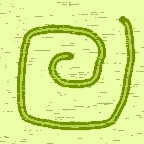
I published a paper ‘zine called the Lime Green News from 1991 to 1998. There were 18 issues. I was burned out on it when I quit, and weirded out (ok, kind of scared) by some of the creepy attention I was getting. At the time I was glad to switch to web sites, e-newsletters and my blog for awhile as a writing outlet. I did a lot of business blogging for clients and employers as well. For about four and a half years I’ve been fantasizing about starting the Lime Green News up again. When it ended it was 24 pages which is a lot of content to get ready all at one time when I haven’t produced a printed ‘zine in so long. I decided to try to bridge the gap with a new mini ‘zine called, what else, Lime Green Mini ‘Zine. I was going for a loose, grungy look for a little 90s nostalgia and hopefully low-tech appeal. I’ll refine the design as I go but I’m pretty excited to get this far. It’s been a long time coming!
I’m going to produce roughly 50 copies of the first issue. While I brainstorm about how to distribute the new ‘zine, here is the Vol 1, No 1 content to explain what I’m doing. I’m also providing a couple of templates for the front and back covers in case you like the format and want to start your own ‘zine. Enjoy!
Click for .jpg template for covers
Click for .jpg template for inner pages
“Welcome to Volume 1, Number 1 of Lime Green Mini ‘Zine!
Back in the 90s, I used to publish a paper ‘zine called the Lime Green News. If you want to see what it looked like I have some back issues for sale in my Etsy shop (etsy.com/shop/CarolynHDesign, look in the Zines and Magazines section). For awhile I didn’t want these old issues to be seen, but they are so old now that it doesn’t matter if they are kind of embarrassing.
The Lime Green News, like my current blog (chasenfratz.com/wp), was about whatever creative projects I was working on or studying at the time. I also published artwork, poetry and articles by other writers and artists. After I learned how to make rudimentary web sites in 1997, my Lime Green News web site (limegreennews.com) gradually replaced my paper ‘zine.
After awhile, the format of the old Lime Green News web site got outdated and embarrassing, just like the paper ‘zine, but I left it online because it had a whole bunch of content on it. Now it’s old enough to be considered “vintage”. Vintage web sites that are still live can serve a valuable function in society. Much of the history and culture of the early Internet years is in danger of being lost. And the World Wide Web is increasingly hostile to any content that is independent and not corporate in origin. One nice thing about a web site made with primitive code is that it still works! While the rest of the web has to keep changing over code to adhere to newer and newer technology, my primitive web site will still run. So instead of being embarrassed that I don’t know the latest ways of coding any more, I’m going to keep doing the primitive code so that the work will hopefully have a long life.
The Lime Green Mini ‘Zine is a little project I’m doing because after years of being away from the ‘zine scene, I want to experiment with getting back into a paper publication I can touch. It’s going to supplement rather than replace my blog. I expect the content will vary according to whatever I’m working on or writing about at the time of publication.
I designed the front cover template to incorporate pockets that I’ll slip little items into. It might be a project or a sample. There are probably some people out there who crave something tangible and tactile to augment all the electronic content we consume. I hope you enjoy it!

http://www.chasenfratz.com/wp/my-former-zine-and-mail-art-days/
End Notes:
You might be asking yourself as you look in the pockets of this issue, what’s up with the Christmas projects? I’m working on projects to submit to magazines, which need seasonal projects far in advance. I got behind on Christmas 2023 because of some personal grief and trouble, so as I get caught up I’m working on next year as well.
Have a great 2024!”













